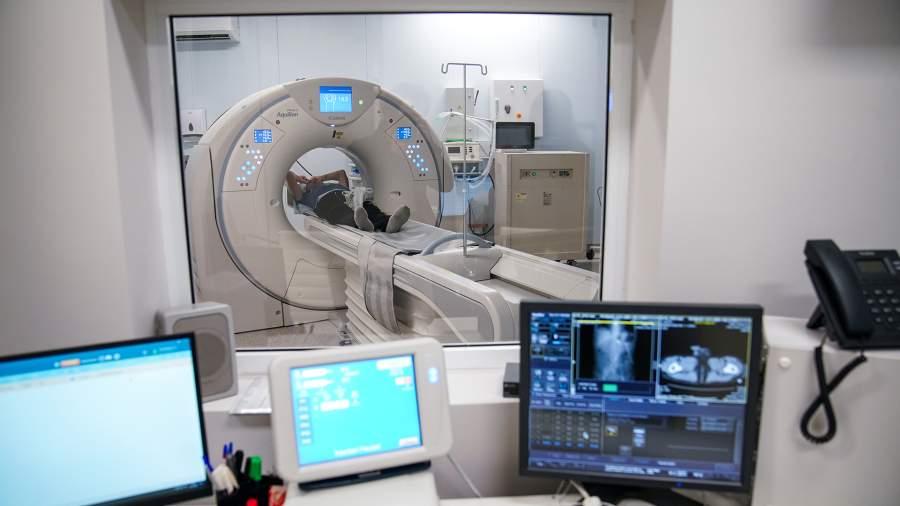Light study: new photodiodes will improve the operation of CT scanners and screening systems
- Статьи
- Science and technology
- Light study: new photodiodes will improve the operation of CT scanners and screening systems

Russian scientists have obtained photodiodes made of perovskite, which are an order of magnitude more sensitive to light than classical silicon elements. Due to these properties, they can be used to create more effective diagnostic devices based on X-rays, as well as video cameras, screening and other systems that are based on light capture. The specialists managed to improve the properties of the material by adding a new polymer to it. According to experts, the technology will allow for deeper scanning of luggage and detect the smallest objects in it, and if you add perovskite to the paint and apply it to the walls of a smart home, it can be turned into one huge sensor.
Photosensitive elements made of perovskite
Specialists from NUST MISIS and the N.S. Enikolopov Institute of Synthetic Polymer Materials of the Russian Academy of Sciences have developed perovskite photodiodes on thin films with an increased response rate and light detection range. They can be used for medical equipment, telecommunications, security systems and other devices for which it is important to capture light radiation. The use of the new material will make it possible to increase the sensitivity of these devices by almost 10 times compared to their classical silicon counterparts. In addition, silicon elements are not produced in Russia, but perovskites can be produced in our country, the scientists said.
— We are developing the technology of micropixel photodiodes based on printed principles. The new study shows an important result: the effective operation of photodiodes for X-ray conversion has been confirmed, which is extremely important for high-resolution medical tomography detectors or security systems. The precise engineering of the interfaces in our devices has made it possible to significantly increase the sensitivity of the devices and suppress noise," Danila Saranin, head of the Laboratory of Advanced Solar Energy at NUST MISIS, told Izvestia.
Perovskite photodiodes can be printed on a wide variety of types of substrates, including flexible plastics, which makes them promising for photosensitive elements of next-generation cameras and imaging systems. However, the developers encountered some difficulties in the production of perovskites. Defects formed at the interface between the perovskite grains, reducing the efficiency of the devices, leading to current leaks and slowing response time. To improve the characteristics of the material, the researchers modified it with a special polymer. This material has dielectric and other important properties that allow it to influence the electric field in the photodiode structure.
—The integration of a small amount of polymer dielectric into the structure of perovskite photodiodes has made it possible to improve the sensitivity of devices, expand the linear dynamic range and increase their performance," said Andrei Morozov, a graduate student at NUST MISIS.
In addition, the polymer layer stabilized the characteristics of perovskite photodiodes under adverse conditions. This is important for its use in devices exposed to changing environmental conditions, as well as for extending their service life.
Perovskite is a relatively rare mineral for the Earth's surface, calcium titanate. It was discovered in the first half of the 19th century in the Urals. Interest in the mineral as a potential semiconductor for photovoltaic systems arose in the 21st century with the advent of thin-film technologies. The perovskite material is capable of converting light into electrical energy with an efficiency similar to silicon.
Inspection systems and wall sensors
As Evgeny Alexandrov, director of the NTI Competence Center "Digital Materials Science: New Materials and Substances" at the Bauman Moscow State Technical University, explained to Izvestia, so far perovskite materials are very short-lived. They are easy to make and apply in a mortar manner. Silicon analogues are less sensitive in light capture, but they prevail in photonics precisely because of their higher stability. Therefore, scientists are trying to find ways to stabilize perovskites with various agents that prevent the formation of defects and degradation of the material's surface.
— The technology is promising for creating flexible electronic devices that are easy to manufacture. You can also imagine a smart house with walls and roof painted with perovskites: every square millimeter of such paint represents a weather or motion sensor, the expert said.
There are already working systems for X-rays, inspection complexes and video cameras, so there is little need for perovskites. This material is less interesting in domestic applications, but is more suitable for special purposes where higher sensitivity and response speed are required, for example, in thermal imagers and cameras tracking fast-moving objects in the field of transport or sports technology, the specialist added.
The proposed technology is promising, since perovskite photodiodes are much easier to manufacture, and increasing their sensitivity and expanding the range of perceived wavelengths increases their applications, says Roman Ponomarev, an expert at the NTI Photonics Competence Center.
— Such devices are best suited for new types of security systems that allow scanning without placing an object in a separate device, as is done now when a backpack in the subway is examined using an X-ray machine. Modification of the inspection systems using the developed new materials will increase their resolution, that is, to see smaller details, as well as increase the list of recognizable substances and objects," he said.
Perovskite-based photodiodes created at the university demonstrate high efficiency due to their ability to detect very weak light signals in a wide spectral range, said Alevtina Chernikova, Rector of NUST MISIS.
According to Dmitry Getz, a leading researcher at the Faculty of Physics at ITMO University, the proposed technology is promising because it allows creating efficient optoelectronic devices using simpler methods without loss of quality. At the same time, the properties of the resulting structures can also be improved by introducing various chemical additives, since the method of solution chemistry is used.
Переведено сервисом «Яндекс Переводчик»
